Case Study Analysis: Applying Motivation Theories to Reward Systems
VerifiedAdded on 2022/09/08
|8
|2182
|10
Case Study
AI Summary
This case study analyzes the challenges faced by Tampani, Inc., a small S-corporation, in implementing a motivating reward system. The report identifies issues such as unclear bonus criteria, unfair stock allocation, and unclear job responsibilities, leading to employee dissatisfaction and reduced motivation. It applies Herzberg's Two-Factor theory, Vroom's Expectancy theory, and Adams' Equity theory to understand the problems. The analysis highlights the importance of hygiene factors, expectancy, and fairness in motivating employees. The report recommends adopting a 360-degree performance appraisal method, Skinner's reinforcement theory, and other strategies to improve reward management, enhance employee satisfaction, and align individual efforts with organizational goals. The conclusion emphasizes the need for clear organizational structure, equitable incentive distribution, and the application of motivational theories to achieve overall organizational objectives.
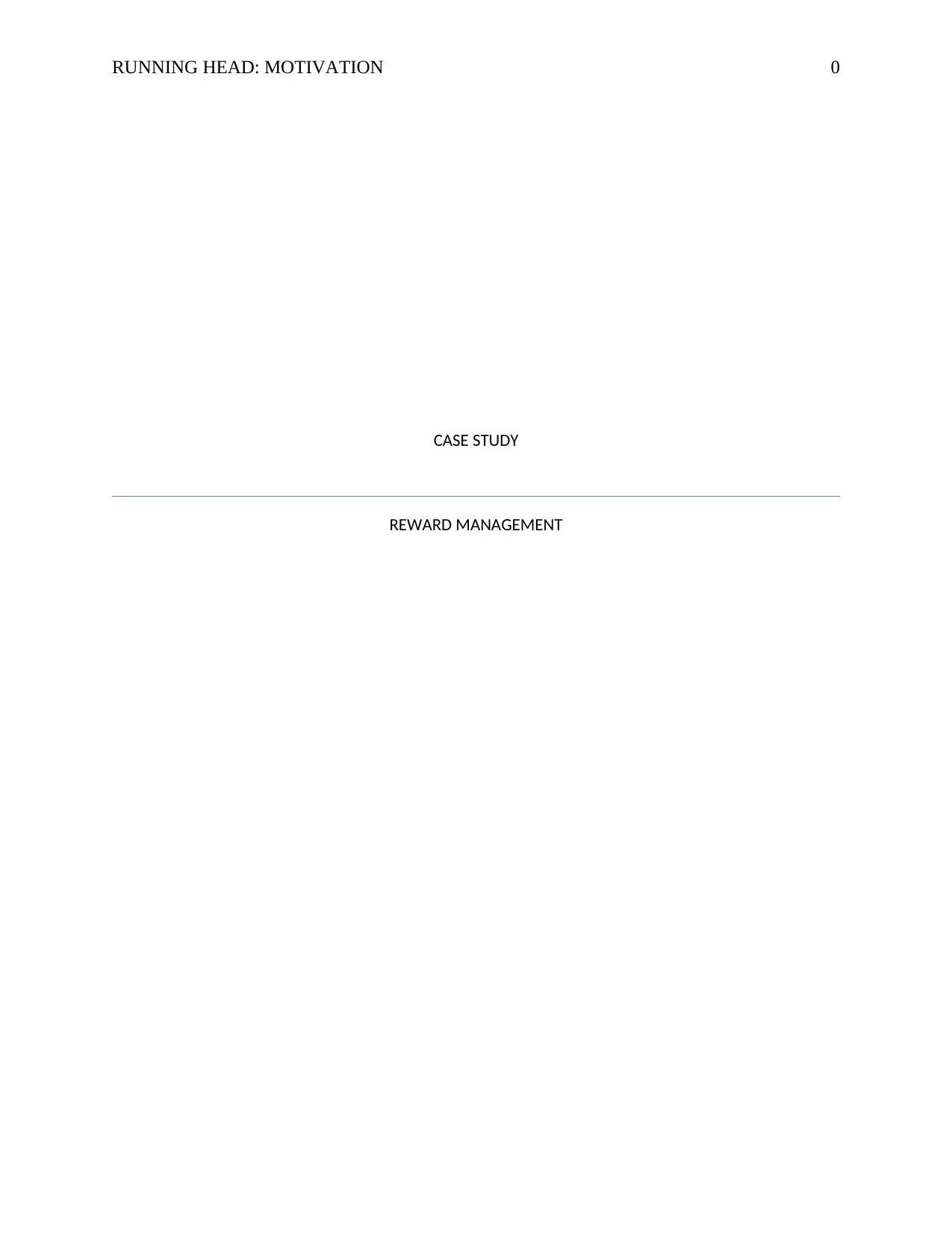
RUNNING HEAD: MOTIVATION 0
CASE STUDY
REWARD MANAGEMENT
CASE STUDY
REWARD MANAGEMENT
Paraphrase This Document
Need a fresh take? Get an instant paraphrase of this document with our AI Paraphraser
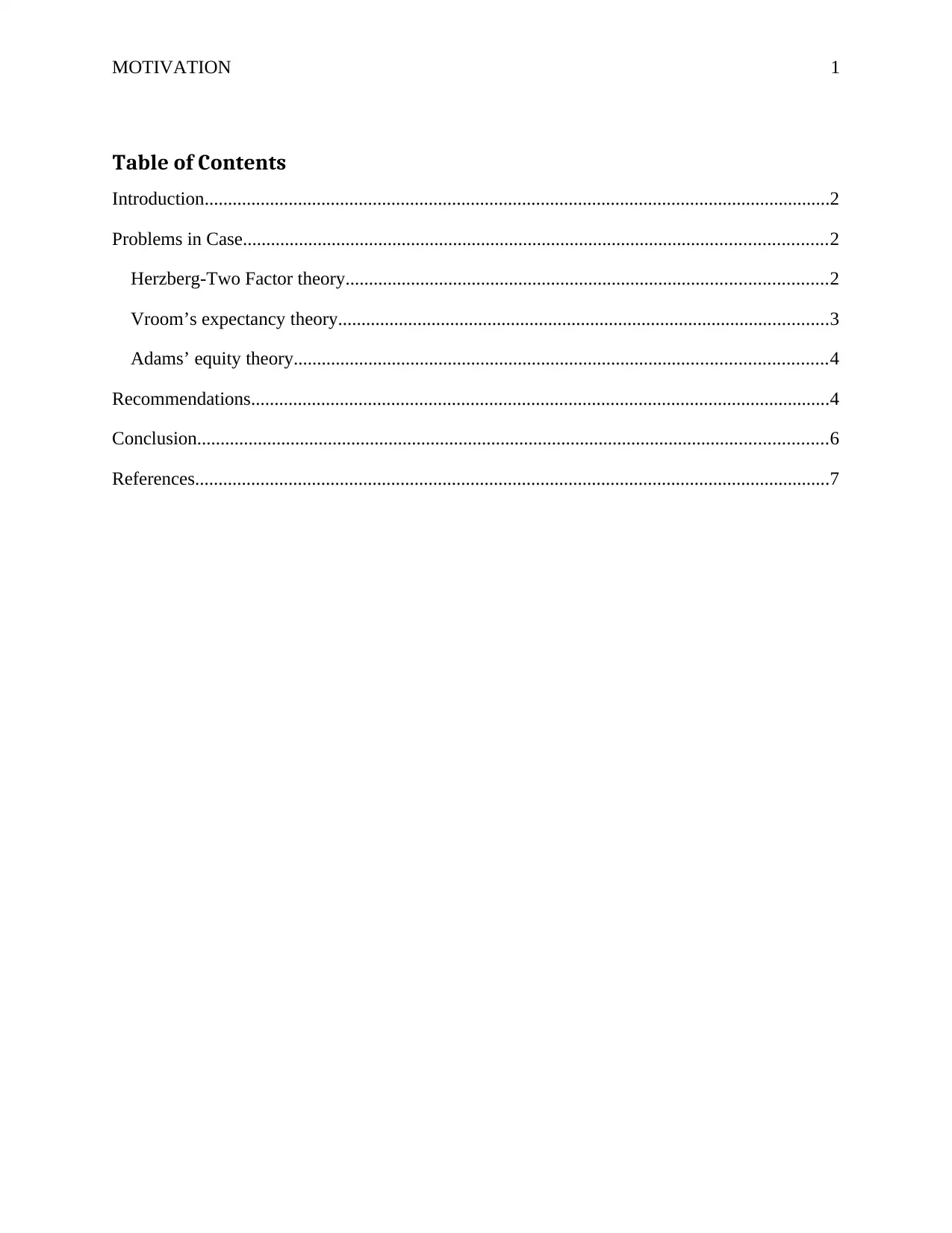
MOTIVATION 1
Table of Contents
Introduction......................................................................................................................................2
Problems in Case.............................................................................................................................2
Herzberg-Two Factor theory.......................................................................................................2
Vroom’s expectancy theory.........................................................................................................3
Adams’ equity theory..................................................................................................................4
Recommendations............................................................................................................................4
Conclusion.......................................................................................................................................6
References........................................................................................................................................7
Table of Contents
Introduction......................................................................................................................................2
Problems in Case.............................................................................................................................2
Herzberg-Two Factor theory.......................................................................................................2
Vroom’s expectancy theory.........................................................................................................3
Adams’ equity theory..................................................................................................................4
Recommendations............................................................................................................................4
Conclusion.......................................................................................................................................6
References........................................................................................................................................7
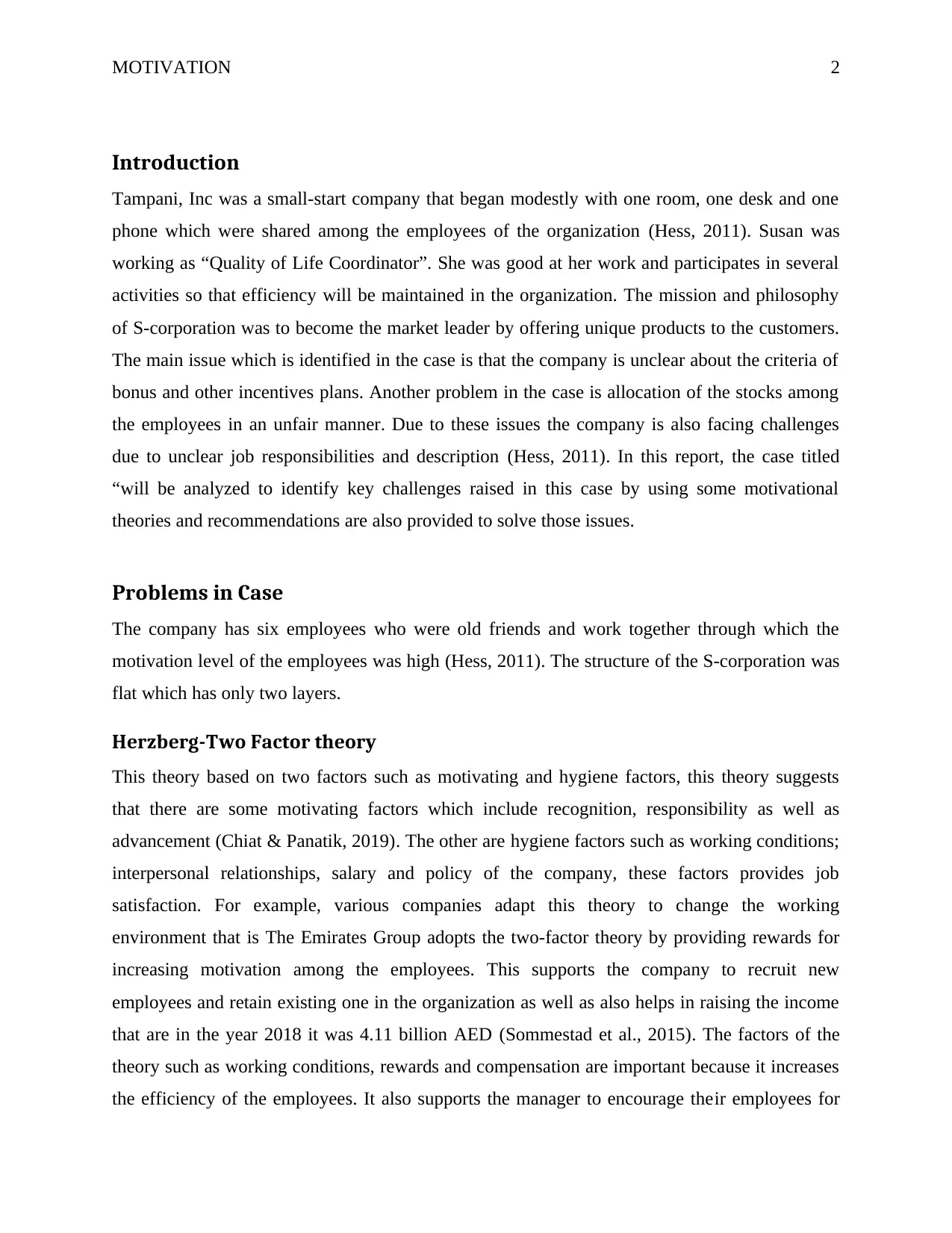
MOTIVATION 2
Introduction
Tampani, Inc was a small-start company that began modestly with one room, one desk and one
phone which were shared among the employees of the organization (Hess, 2011). Susan was
working as “Quality of Life Coordinator”. She was good at her work and participates in several
activities so that efficiency will be maintained in the organization. The mission and philosophy
of S-corporation was to become the market leader by offering unique products to the customers.
The main issue which is identified in the case is that the company is unclear about the criteria of
bonus and other incentives plans. Another problem in the case is allocation of the stocks among
the employees in an unfair manner. Due to these issues the company is also facing challenges
due to unclear job responsibilities and description (Hess, 2011). In this report, the case titled
“will be analyzed to identify key challenges raised in this case by using some motivational
theories and recommendations are also provided to solve those issues.
Problems in Case
The company has six employees who were old friends and work together through which the
motivation level of the employees was high (Hess, 2011). The structure of the S-corporation was
flat which has only two layers.
Herzberg-Two Factor theory
This theory based on two factors such as motivating and hygiene factors, this theory suggests
that there are some motivating factors which include recognition, responsibility as well as
advancement (Chiat & Panatik, 2019). The other are hygiene factors such as working conditions;
interpersonal relationships, salary and policy of the company, these factors provides job
satisfaction. For example, various companies adapt this theory to change the working
environment that is The Emirates Group adopts the two-factor theory by providing rewards for
increasing motivation among the employees. This supports the company to recruit new
employees and retain existing one in the organization as well as also helps in raising the income
that are in the year 2018 it was 4.11 billion AED (Sommestad et al., 2015). The factors of the
theory such as working conditions, rewards and compensation are important because it increases
the efficiency of the employees. It also supports the manager to encourage their employees for
Introduction
Tampani, Inc was a small-start company that began modestly with one room, one desk and one
phone which were shared among the employees of the organization (Hess, 2011). Susan was
working as “Quality of Life Coordinator”. She was good at her work and participates in several
activities so that efficiency will be maintained in the organization. The mission and philosophy
of S-corporation was to become the market leader by offering unique products to the customers.
The main issue which is identified in the case is that the company is unclear about the criteria of
bonus and other incentives plans. Another problem in the case is allocation of the stocks among
the employees in an unfair manner. Due to these issues the company is also facing challenges
due to unclear job responsibilities and description (Hess, 2011). In this report, the case titled
“will be analyzed to identify key challenges raised in this case by using some motivational
theories and recommendations are also provided to solve those issues.
Problems in Case
The company has six employees who were old friends and work together through which the
motivation level of the employees was high (Hess, 2011). The structure of the S-corporation was
flat which has only two layers.
Herzberg-Two Factor theory
This theory based on two factors such as motivating and hygiene factors, this theory suggests
that there are some motivating factors which include recognition, responsibility as well as
advancement (Chiat & Panatik, 2019). The other are hygiene factors such as working conditions;
interpersonal relationships, salary and policy of the company, these factors provides job
satisfaction. For example, various companies adapt this theory to change the working
environment that is The Emirates Group adopts the two-factor theory by providing rewards for
increasing motivation among the employees. This supports the company to recruit new
employees and retain existing one in the organization as well as also helps in raising the income
that are in the year 2018 it was 4.11 billion AED (Sommestad et al., 2015). The factors of the
theory such as working conditions, rewards and compensation are important because it increases
the efficiency of the employees. It also supports the manager to encourage their employees for
⊘ This is a preview!⊘
Do you want full access?
Subscribe today to unlock all pages.

Trusted by 1+ million students worldwide
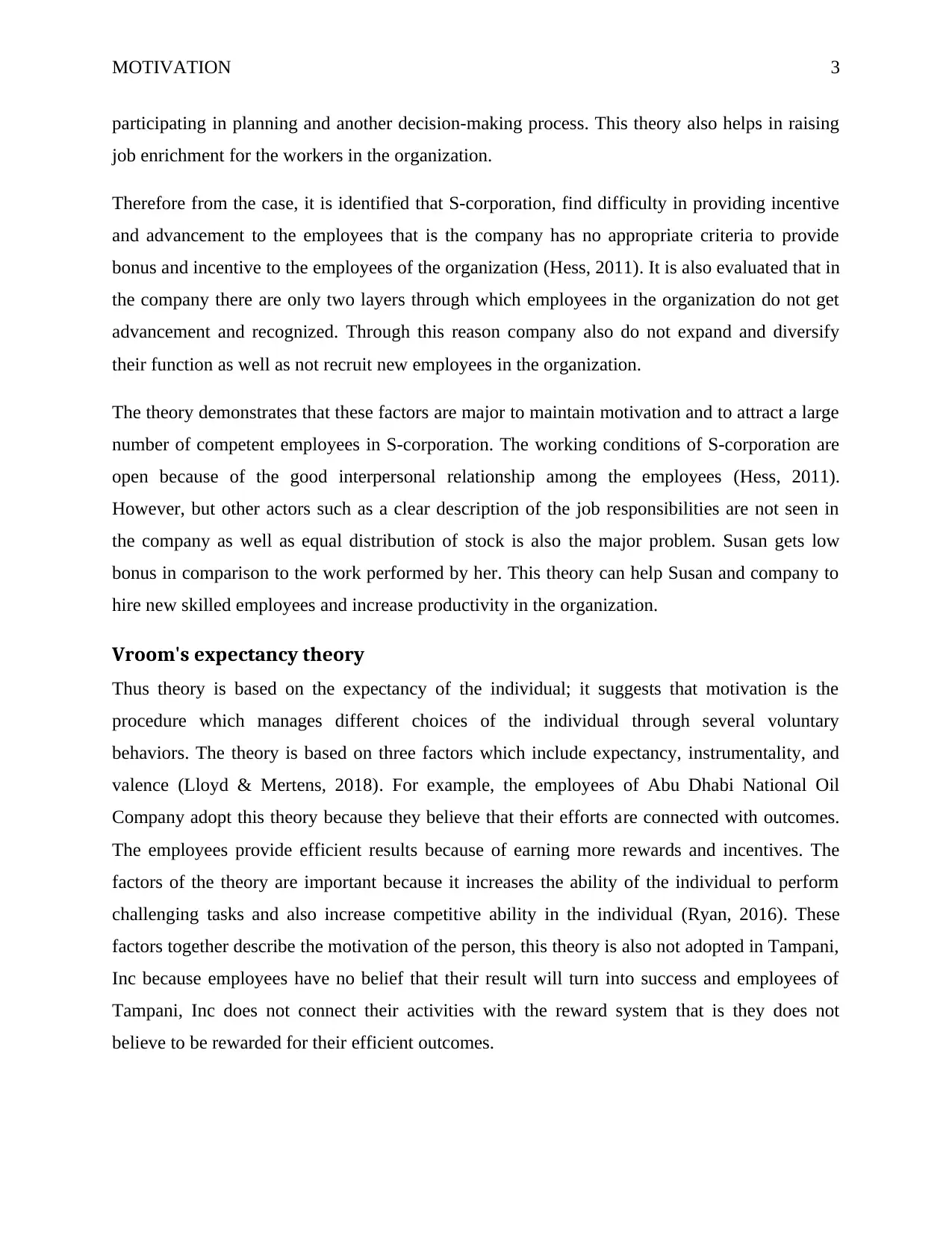
MOTIVATION 3
participating in planning and another decision-making process. This theory also helps in raising
job enrichment for the workers in the organization.
Therefore from the case, it is identified that S-corporation, find difficulty in providing incentive
and advancement to the employees that is the company has no appropriate criteria to provide
bonus and incentive to the employees of the organization (Hess, 2011). It is also evaluated that in
the company there are only two layers through which employees in the organization do not get
advancement and recognized. Through this reason company also do not expand and diversify
their function as well as not recruit new employees in the organization.
The theory demonstrates that these factors are major to maintain motivation and to attract a large
number of competent employees in S-corporation. The working conditions of S-corporation are
open because of the good interpersonal relationship among the employees (Hess, 2011).
However, but other actors such as a clear description of the job responsibilities are not seen in
the company as well as equal distribution of stock is also the major problem. Susan gets low
bonus in comparison to the work performed by her. This theory can help Susan and company to
hire new skilled employees and increase productivity in the organization.
Vroom's expectancy theory
Thus theory is based on the expectancy of the individual; it suggests that motivation is the
procedure which manages different choices of the individual through several voluntary
behaviors. The theory is based on three factors which include expectancy, instrumentality, and
valence (Lloyd & Mertens, 2018). For example, the employees of Abu Dhabi National Oil
Company adopt this theory because they believe that their efforts are connected with outcomes.
The employees provide efficient results because of earning more rewards and incentives. The
factors of the theory are important because it increases the ability of the individual to perform
challenging tasks and also increase competitive ability in the individual (Ryan, 2016). These
factors together describe the motivation of the person, this theory is also not adopted in Tampani,
Inc because employees have no belief that their result will turn into success and employees of
Tampani, Inc does not connect their activities with the reward system that is they does not
believe to be rewarded for their efficient outcomes.
participating in planning and another decision-making process. This theory also helps in raising
job enrichment for the workers in the organization.
Therefore from the case, it is identified that S-corporation, find difficulty in providing incentive
and advancement to the employees that is the company has no appropriate criteria to provide
bonus and incentive to the employees of the organization (Hess, 2011). It is also evaluated that in
the company there are only two layers through which employees in the organization do not get
advancement and recognized. Through this reason company also do not expand and diversify
their function as well as not recruit new employees in the organization.
The theory demonstrates that these factors are major to maintain motivation and to attract a large
number of competent employees in S-corporation. The working conditions of S-corporation are
open because of the good interpersonal relationship among the employees (Hess, 2011).
However, but other actors such as a clear description of the job responsibilities are not seen in
the company as well as equal distribution of stock is also the major problem. Susan gets low
bonus in comparison to the work performed by her. This theory can help Susan and company to
hire new skilled employees and increase productivity in the organization.
Vroom's expectancy theory
Thus theory is based on the expectancy of the individual; it suggests that motivation is the
procedure which manages different choices of the individual through several voluntary
behaviors. The theory is based on three factors which include expectancy, instrumentality, and
valence (Lloyd & Mertens, 2018). For example, the employees of Abu Dhabi National Oil
Company adopt this theory because they believe that their efforts are connected with outcomes.
The employees provide efficient results because of earning more rewards and incentives. The
factors of the theory are important because it increases the ability of the individual to perform
challenging tasks and also increase competitive ability in the individual (Ryan, 2016). These
factors together describe the motivation of the person, this theory is also not adopted in Tampani,
Inc because employees have no belief that their result will turn into success and employees of
Tampani, Inc does not connect their activities with the reward system that is they does not
believe to be rewarded for their efficient outcomes.
Paraphrase This Document
Need a fresh take? Get an instant paraphrase of this document with our AI Paraphraser
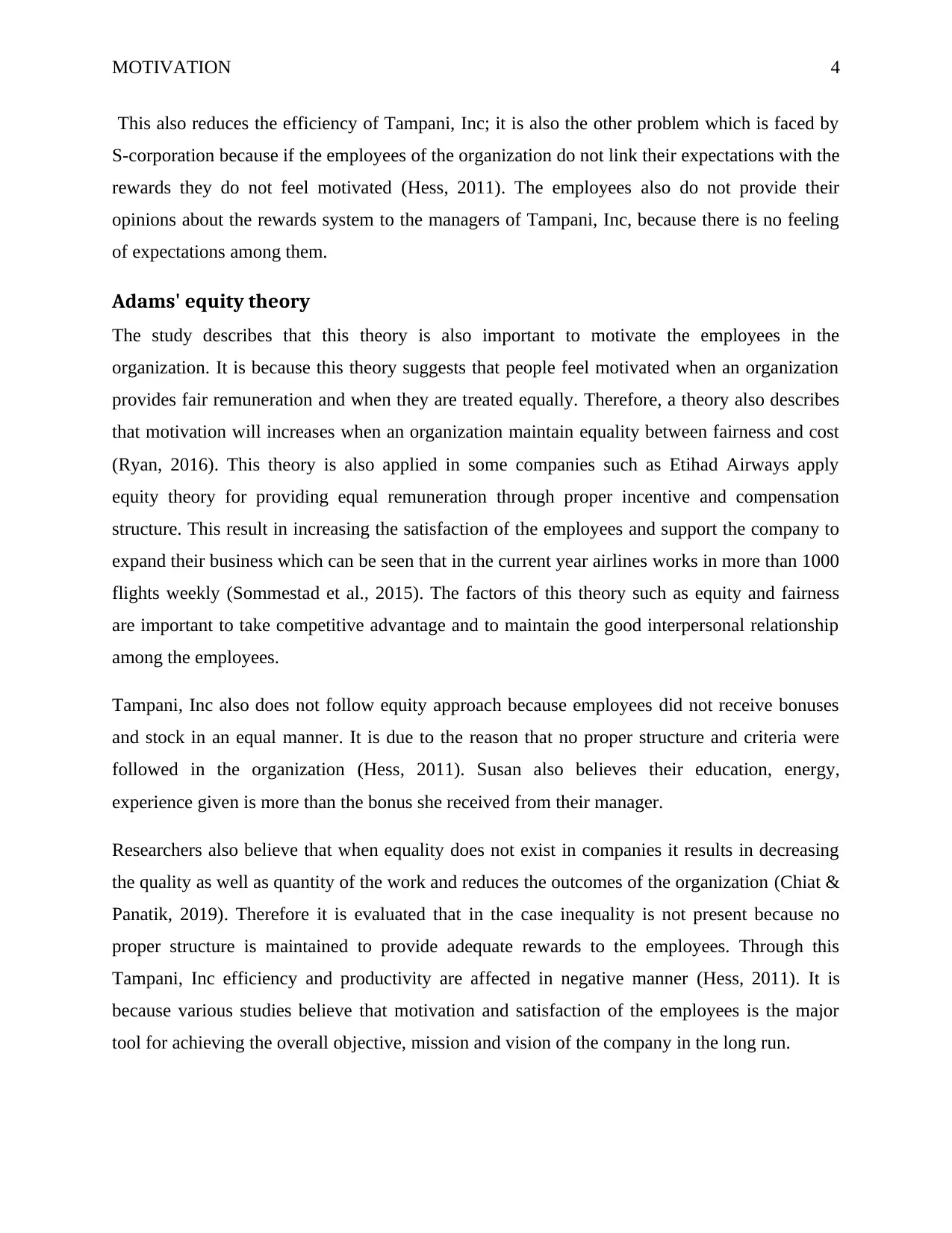
MOTIVATION 4
This also reduces the efficiency of Tampani, Inc; it is also the other problem which is faced by
S-corporation because if the employees of the organization do not link their expectations with the
rewards they do not feel motivated (Hess, 2011). The employees also do not provide their
opinions about the rewards system to the managers of Tampani, Inc, because there is no feeling
of expectations among them.
Adams' equity theory
The study describes that this theory is also important to motivate the employees in the
organization. It is because this theory suggests that people feel motivated when an organization
provides fair remuneration and when they are treated equally. Therefore, a theory also describes
that motivation will increases when an organization maintain equality between fairness and cost
(Ryan, 2016). This theory is also applied in some companies such as Etihad Airways apply
equity theory for providing equal remuneration through proper incentive and compensation
structure. This result in increasing the satisfaction of the employees and support the company to
expand their business which can be seen that in the current year airlines works in more than 1000
flights weekly (Sommestad et al., 2015). The factors of this theory such as equity and fairness
are important to take competitive advantage and to maintain the good interpersonal relationship
among the employees.
Tampani, Inc also does not follow equity approach because employees did not receive bonuses
and stock in an equal manner. It is due to the reason that no proper structure and criteria were
followed in the organization (Hess, 2011). Susan also believes their education, energy,
experience given is more than the bonus she received from their manager.
Researchers also believe that when equality does not exist in companies it results in decreasing
the quality as well as quantity of the work and reduces the outcomes of the organization (Chiat &
Panatik, 2019). Therefore it is evaluated that in the case inequality is not present because no
proper structure is maintained to provide adequate rewards to the employees. Through this
Tampani, Inc efficiency and productivity are affected in negative manner (Hess, 2011). It is
because various studies believe that motivation and satisfaction of the employees is the major
tool for achieving the overall objective, mission and vision of the company in the long run.
This also reduces the efficiency of Tampani, Inc; it is also the other problem which is faced by
S-corporation because if the employees of the organization do not link their expectations with the
rewards they do not feel motivated (Hess, 2011). The employees also do not provide their
opinions about the rewards system to the managers of Tampani, Inc, because there is no feeling
of expectations among them.
Adams' equity theory
The study describes that this theory is also important to motivate the employees in the
organization. It is because this theory suggests that people feel motivated when an organization
provides fair remuneration and when they are treated equally. Therefore, a theory also describes
that motivation will increases when an organization maintain equality between fairness and cost
(Ryan, 2016). This theory is also applied in some companies such as Etihad Airways apply
equity theory for providing equal remuneration through proper incentive and compensation
structure. This result in increasing the satisfaction of the employees and support the company to
expand their business which can be seen that in the current year airlines works in more than 1000
flights weekly (Sommestad et al., 2015). The factors of this theory such as equity and fairness
are important to take competitive advantage and to maintain the good interpersonal relationship
among the employees.
Tampani, Inc also does not follow equity approach because employees did not receive bonuses
and stock in an equal manner. It is due to the reason that no proper structure and criteria were
followed in the organization (Hess, 2011). Susan also believes their education, energy,
experience given is more than the bonus she received from their manager.
Researchers also believe that when equality does not exist in companies it results in decreasing
the quality as well as quantity of the work and reduces the outcomes of the organization (Chiat &
Panatik, 2019). Therefore it is evaluated that in the case inequality is not present because no
proper structure is maintained to provide adequate rewards to the employees. Through this
Tampani, Inc efficiency and productivity are affected in negative manner (Hess, 2011). It is
because various studies believe that motivation and satisfaction of the employees is the major
tool for achieving the overall objective, mission and vision of the company in the long run.
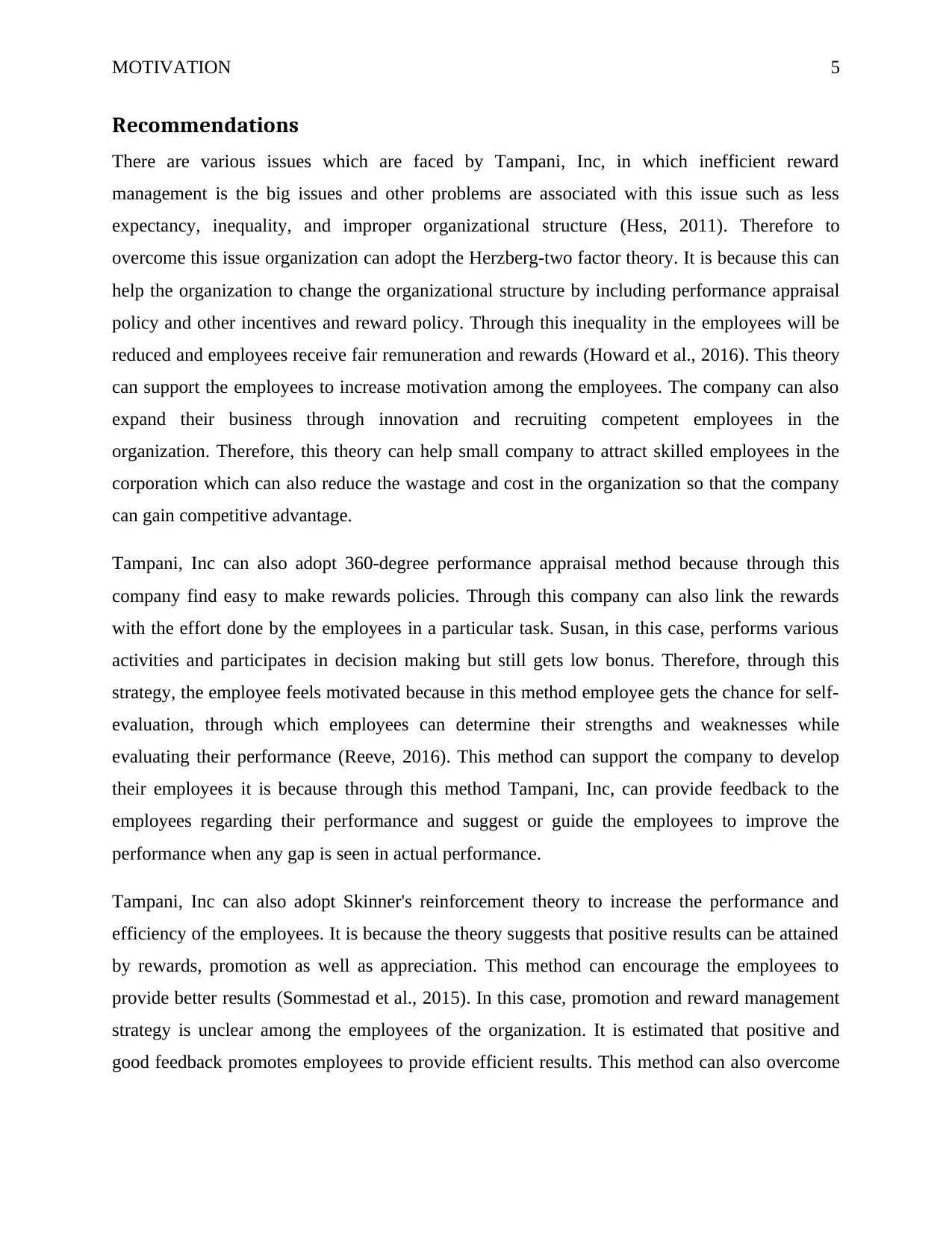
MOTIVATION 5
Recommendations
There are various issues which are faced by Tampani, Inc, in which inefficient reward
management is the big issues and other problems are associated with this issue such as less
expectancy, inequality, and improper organizational structure (Hess, 2011). Therefore to
overcome this issue organization can adopt the Herzberg-two factor theory. It is because this can
help the organization to change the organizational structure by including performance appraisal
policy and other incentives and reward policy. Through this inequality in the employees will be
reduced and employees receive fair remuneration and rewards (Howard et al., 2016). This theory
can support the employees to increase motivation among the employees. The company can also
expand their business through innovation and recruiting competent employees in the
organization. Therefore, this theory can help small company to attract skilled employees in the
corporation which can also reduce the wastage and cost in the organization so that the company
can gain competitive advantage.
Tampani, Inc can also adopt 360-degree performance appraisal method because through this
company find easy to make rewards policies. Through this company can also link the rewards
with the effort done by the employees in a particular task. Susan, in this case, performs various
activities and participates in decision making but still gets low bonus. Therefore, through this
strategy, the employee feels motivated because in this method employee gets the chance for self-
evaluation, through which employees can determine their strengths and weaknesses while
evaluating their performance (Reeve, 2016). This method can support the company to develop
their employees it is because through this method Tampani, Inc, can provide feedback to the
employees regarding their performance and suggest or guide the employees to improve the
performance when any gap is seen in actual performance.
Tampani, Inc can also adopt Skinner's reinforcement theory to increase the performance and
efficiency of the employees. It is because the theory suggests that positive results can be attained
by rewards, promotion as well as appreciation. This method can encourage the employees to
provide better results (Sommestad et al., 2015). In this case, promotion and reward management
strategy is unclear among the employees of the organization. It is estimated that positive and
good feedback promotes employees to provide efficient results. This method can also overcome
Recommendations
There are various issues which are faced by Tampani, Inc, in which inefficient reward
management is the big issues and other problems are associated with this issue such as less
expectancy, inequality, and improper organizational structure (Hess, 2011). Therefore to
overcome this issue organization can adopt the Herzberg-two factor theory. It is because this can
help the organization to change the organizational structure by including performance appraisal
policy and other incentives and reward policy. Through this inequality in the employees will be
reduced and employees receive fair remuneration and rewards (Howard et al., 2016). This theory
can support the employees to increase motivation among the employees. The company can also
expand their business through innovation and recruiting competent employees in the
organization. Therefore, this theory can help small company to attract skilled employees in the
corporation which can also reduce the wastage and cost in the organization so that the company
can gain competitive advantage.
Tampani, Inc can also adopt 360-degree performance appraisal method because through this
company find easy to make rewards policies. Through this company can also link the rewards
with the effort done by the employees in a particular task. Susan, in this case, performs various
activities and participates in decision making but still gets low bonus. Therefore, through this
strategy, the employee feels motivated because in this method employee gets the chance for self-
evaluation, through which employees can determine their strengths and weaknesses while
evaluating their performance (Reeve, 2016). This method can support the company to develop
their employees it is because through this method Tampani, Inc, can provide feedback to the
employees regarding their performance and suggest or guide the employees to improve the
performance when any gap is seen in actual performance.
Tampani, Inc can also adopt Skinner's reinforcement theory to increase the performance and
efficiency of the employees. It is because the theory suggests that positive results can be attained
by rewards, promotion as well as appreciation. This method can encourage the employees to
provide better results (Sommestad et al., 2015). In this case, promotion and reward management
strategy is unclear among the employees of the organization. It is estimated that positive and
good feedback promotes employees to provide efficient results. This method can also overcome
⊘ This is a preview!⊘
Do you want full access?
Subscribe today to unlock all pages.

Trusted by 1+ million students worldwide
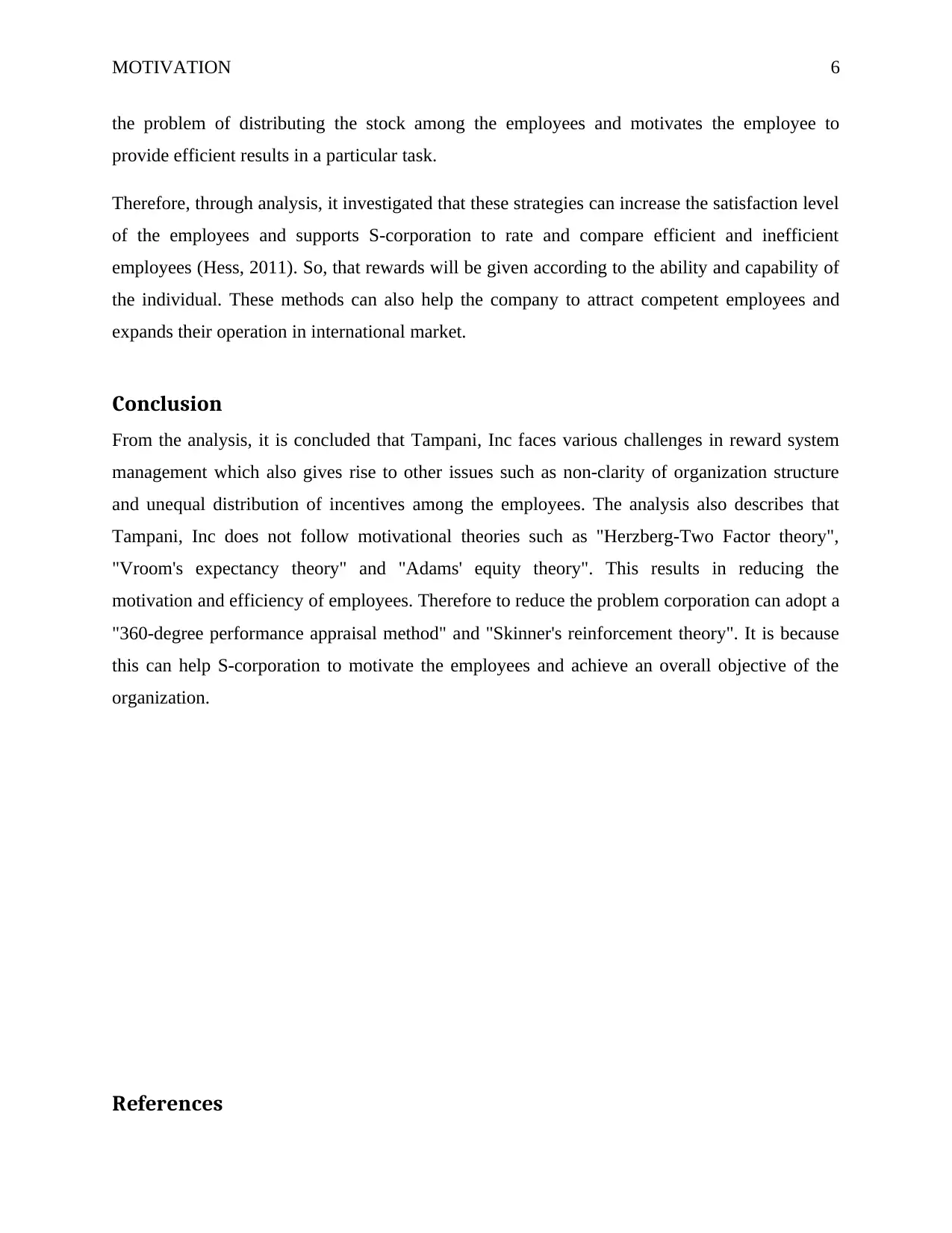
MOTIVATION 6
the problem of distributing the stock among the employees and motivates the employee to
provide efficient results in a particular task.
Therefore, through analysis, it investigated that these strategies can increase the satisfaction level
of the employees and supports S-corporation to rate and compare efficient and inefficient
employees (Hess, 2011). So, that rewards will be given according to the ability and capability of
the individual. These methods can also help the company to attract competent employees and
expands their operation in international market.
Conclusion
From the analysis, it is concluded that Tampani, Inc faces various challenges in reward system
management which also gives rise to other issues such as non-clarity of organization structure
and unequal distribution of incentives among the employees. The analysis also describes that
Tampani, Inc does not follow motivational theories such as "Herzberg-Two Factor theory",
"Vroom's expectancy theory" and "Adams' equity theory". This results in reducing the
motivation and efficiency of employees. Therefore to reduce the problem corporation can adopt a
"360-degree performance appraisal method" and "Skinner's reinforcement theory". It is because
this can help S-corporation to motivate the employees and achieve an overall objective of the
organization.
References
the problem of distributing the stock among the employees and motivates the employee to
provide efficient results in a particular task.
Therefore, through analysis, it investigated that these strategies can increase the satisfaction level
of the employees and supports S-corporation to rate and compare efficient and inefficient
employees (Hess, 2011). So, that rewards will be given according to the ability and capability of
the individual. These methods can also help the company to attract competent employees and
expands their operation in international market.
Conclusion
From the analysis, it is concluded that Tampani, Inc faces various challenges in reward system
management which also gives rise to other issues such as non-clarity of organization structure
and unequal distribution of incentives among the employees. The analysis also describes that
Tampani, Inc does not follow motivational theories such as "Herzberg-Two Factor theory",
"Vroom's expectancy theory" and "Adams' equity theory". This results in reducing the
motivation and efficiency of employees. Therefore to reduce the problem corporation can adopt a
"360-degree performance appraisal method" and "Skinner's reinforcement theory". It is because
this can help S-corporation to motivate the employees and achieve an overall objective of the
organization.
References
Paraphrase This Document
Need a fresh take? Get an instant paraphrase of this document with our AI Paraphraser
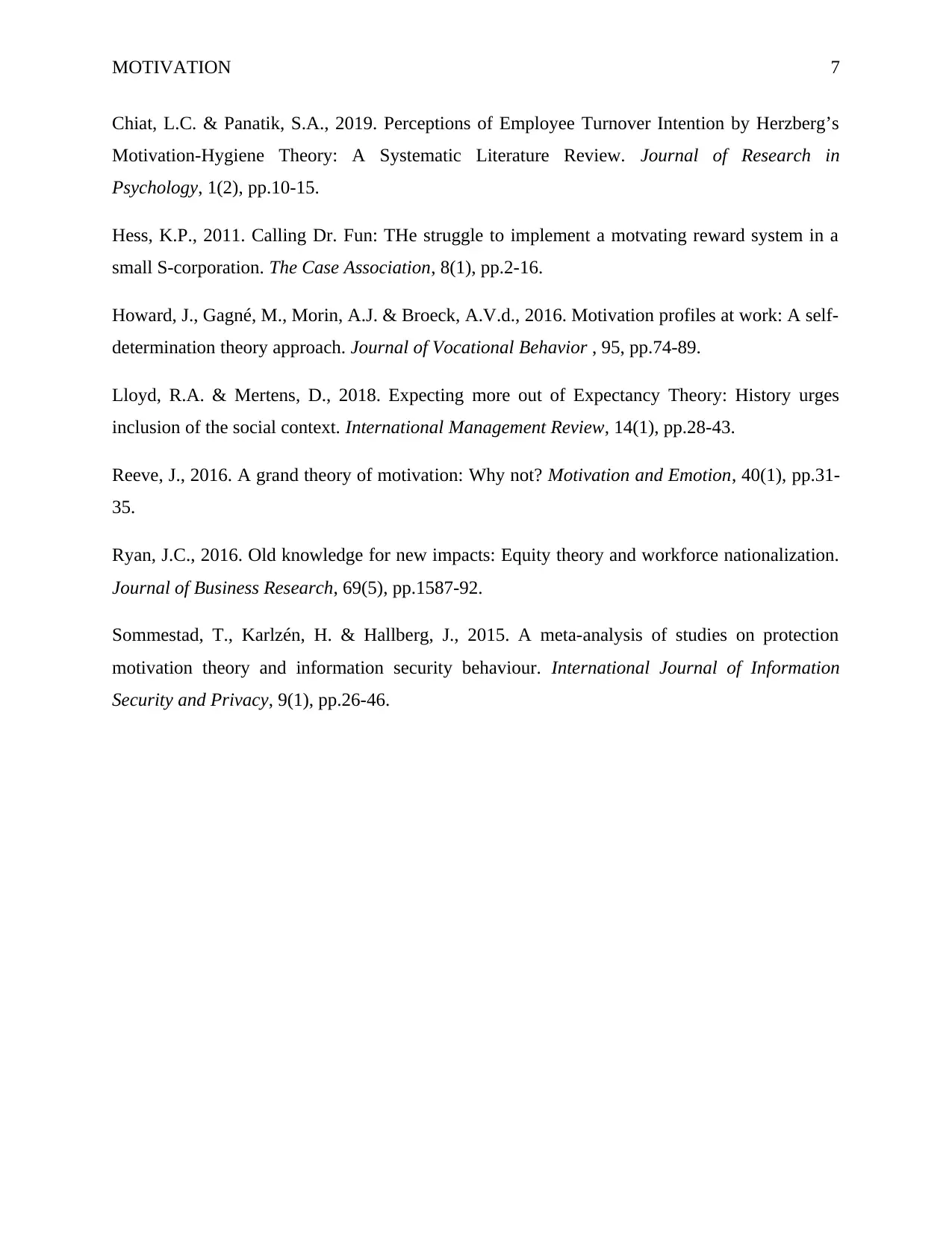
MOTIVATION 7
Chiat, L.C. & Panatik, S.A., 2019. Perceptions of Employee Turnover Intention by Herzberg’s
Motivation-Hygiene Theory: A Systematic Literature Review. Journal of Research in
Psychology, 1(2), pp.10-15.
Hess, K.P., 2011. Calling Dr. Fun: THe struggle to implement a motvating reward system in a
small S-corporation. The Case Association, 8(1), pp.2-16.
Howard, J., Gagné, M., Morin, A.J. & Broeck, A.V.d., 2016. Motivation profiles at work: A self-
determination theory approach. Journal of Vocational Behavior , 95, pp.74-89.
Lloyd, R.A. & Mertens, D., 2018. Expecting more out of Expectancy Theory: History urges
inclusion of the social context. International Management Review, 14(1), pp.28-43.
Reeve, J., 2016. A grand theory of motivation: Why not? Motivation and Emotion, 40(1), pp.31-
35.
Ryan, J.C., 2016. Old knowledge for new impacts: Equity theory and workforce nationalization.
Journal of Business Research, 69(5), pp.1587-92.
Sommestad, T., Karlzén, H. & Hallberg, J., 2015. A meta-analysis of studies on protection
motivation theory and information security behaviour. International Journal of Information
Security and Privacy, 9(1), pp.26-46.
Chiat, L.C. & Panatik, S.A., 2019. Perceptions of Employee Turnover Intention by Herzberg’s
Motivation-Hygiene Theory: A Systematic Literature Review. Journal of Research in
Psychology, 1(2), pp.10-15.
Hess, K.P., 2011. Calling Dr. Fun: THe struggle to implement a motvating reward system in a
small S-corporation. The Case Association, 8(1), pp.2-16.
Howard, J., Gagné, M., Morin, A.J. & Broeck, A.V.d., 2016. Motivation profiles at work: A self-
determination theory approach. Journal of Vocational Behavior , 95, pp.74-89.
Lloyd, R.A. & Mertens, D., 2018. Expecting more out of Expectancy Theory: History urges
inclusion of the social context. International Management Review, 14(1), pp.28-43.
Reeve, J., 2016. A grand theory of motivation: Why not? Motivation and Emotion, 40(1), pp.31-
35.
Ryan, J.C., 2016. Old knowledge for new impacts: Equity theory and workforce nationalization.
Journal of Business Research, 69(5), pp.1587-92.
Sommestad, T., Karlzén, H. & Hallberg, J., 2015. A meta-analysis of studies on protection
motivation theory and information security behaviour. International Journal of Information
Security and Privacy, 9(1), pp.26-46.
1 out of 8
Related Documents
Your All-in-One AI-Powered Toolkit for Academic Success.
+13062052269
info@desklib.com
Available 24*7 on WhatsApp / Email
![[object Object]](/_next/static/media/star-bottom.7253800d.svg)
Unlock your academic potential
Copyright © 2020–2025 A2Z Services. All Rights Reserved. Developed and managed by ZUCOL.





